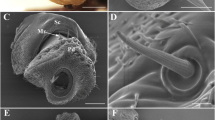Abstract
The external structures of the proboscis are investigated in eye-frequenting species of Noctuidae, Geometridae and Pyralidae by means of scanning electron microscopy. They are compared with non-eye-frequenting representatives of these families. In Noctuidae, highly specialized fruit-piercing, skin-piercing blood-sucking, and sweat-feeding representatives have been included. All hemi- and eulachryphagous species have a soft proboscis tip which is characterized by few sensilla and strongly elongated, dentate plates of the dorsal galeal linkage. The latter structures leave broad gaps between them that lead into the food canal at the tip. This arrangement permits the uptake of fluid suspensions such as lachrymal fluid, wound exudates and pus. The modified dorsal galeal linkage is regarded as an adaptation for this highly derived feeding habit. The rough surface of the proboscis is likely to cause irritation and possible mechanical damage to the conjunctiva and cornea which results in an increased lachrymal flow and production of pus. In contrast to fruit-piercing and skin-piercing Noctuidae, there are no erectile structures on the proboscis of eye-frequenting species.—The comparison with related non-eye-frequenting species demonstrates that the particular morphology of the proboscis tip in lachryphagous moths evolved convergently in different families of Leipdoptera.
Similar content being viewed by others
References
Adler PH (1982) Soil- and puddle-visiting habits of moths. J. Lepid Soc 36/3: 161–173
Altner H, Altner I (1986) Sensilla with both, terminal pore and wall pores on the proboscis of the moth,Rhodogastria bubo Walker (Lepidoptera: Arctiidae). Zool Anz 216/3,4: 129–150
Bänziger H (1968) Preliminary observations on a skin-piercing blood-sucking moth (Calyptra eustrigata) (Hmps) (Lep, Noctuidae) in Malaya. Bull Entomol Res 58: 159–163
Bänziger H (1970) The piercing mechanism of the fruit-piercing mothCalpe [Calyptra] thalictri Bkh (Noctuidae) with reference to the skin-piercing blood-sucking mothC. eustrigata Hmps. Acta Trop 27: 53–88
Bänziger H (1973) Biologie der lacriphagen Lepidopteren in Thailand and Malaya. Rev Suisse Zool 79: 1381–1469
Bänziger H (1980) Skin-piercing blood-sucking moths III: feeding act and piercing mechanism ofCalyptra eustrigata (Hmps) (Lep, Noctuidae), Mitt Schweiz ent Ges 53: 127–142
Bänziger H (1982) Fruit-piercing moths (Lep, Noctuidae) in Thailand: A general survey and some new perspectives, Mitt Schweiz ent Ges 55: 213–240
Bänziger H (1983) A taxonomic revision of the fruit-piercing and blood-sucking moth genusCalyptra Ochsenheimer [=Calyptra Treitschke] (Lepidoptera Noctuidae). Ent Scand 14: 467–491
Bänziger H (1987) Description of new moths which settle on man and animals in SE Asia (generaThliptoceras Hemiscopis, Toxobotys, Pyralidae, Leipid.). Rev Suisse Zool 94: 671–681
Bänziger H (1992) Remarkable new cases of moths drinking human tears in Thailand (Lepidoptera: Thyatiridae, Sphingidae, Notodontidae), Nat Hist Bull Soc Siam 40: 91–102
Bänziger H (1995)Microstega homoculorum sp.n.—the most frequently observed lachryphagous moth of man (Lepidoptera, Pyralidae: Pyraustinae). Rev Suiss Zool 102/2:265–276
Bänziger H, Büttiker W (1969) Records of eye-frequenting Lepidoptera from man. J Med Entomol 6: 53–58
Blaney WM, Simmonds SJ (1988) Food selection in adults and larvae of three species of Lepidoptera: a behavioural and electrophysiological study. Entomol Exp Appl 49: 111–121
Börner C (1939) Die Grundlagen meines Lepidopterensystems. Verh 7. Int Kongr Entomologie 2: 1374–1424
Büttiker W (1959) Observation of feeding habits of adult Westermanniinae (Lepid, Noctuidae) in Cambodia. Acta Trop 16: 356–361
Büttiker W (1962) Biological and morphological notes on the fruit-piercing and eye-frequenting moths. 11. Int Kongr Entomologie Wien (1960) 2: 10–17
Büttiker W (1967) Biological notes on eye-frequenting moths from N Thailand. Mitt Schweiz Entomol Ges 39/3,4: 151–179
Büttiker W (1970) Strange parasites of the eye. Ciba Symposium 17: 22–29
Büttiker W (1973) Vorläufige Beobachtungen an augenbesuchenden Schmetterlingen in der Elfenbeinküste. Rev Suisse Zool 80: 1–43
Büttiker W (1993) Domestic and wild mammalian hosts of ophthalmotropic Lepidoptera in Africa. Entomologist Extraordinary. S Afr Inst Med Res, Johannesburg, pp 5–9
Büttiker W (1996) Midgut structure and contents in some higher moths, especially in eye-frequenting taxa. Entomol Basiliensia (in press)
Darwin F (1875) On the structure of the proboscis ofOphideres fullonica, on orange-sucking moth. Quart J Microsc Sci 15: 385–390
Downes JA (1973) Lepidoptera feeding at puddle-margins, dung, and carrion. J Lepid Soc 27/2: 89–99
Estham LES, Eassa JEE (1955) The feeding mechanism of the butterflyPieris brassicae. Phil Trans R Soc London B 239: 1–43
Frings H, Frings M (1956) The loci of contact chemoreceptors involved in feeding reactions in certain Lepidoptera. Biol Bull 110: 291–299
Gouws JJ, Coetzer JAW, Howell PG (1995) A comparative microbiological study of clinically healthy eyes and those affected by ophthalmia in cattle and the association of noctuid eye-frequenting moths. Tydskr S Afr Vet Assoc 66/3: 160–169
Krenn HW (1990) Functional morphology and movements of the proboscis of Lepidoptera (Insecta). Zoomorphology 110: 105–114
Nicolet J, Büttiker W (1975a) Observations sur la kérato-conjonctivite infectieuse du bovin en Côte d'Ivoire 1. Aspects microbiologiques. Rev Elev Med Vet Pays Trop 28/2: 115–124
Nicolet J, Büttiker W (1975b) Observations sur la kératoconjonctivite infectieuse du bovin en Côte d'Ivoire 2. Étude sur le rôle vecteur des lépidoptères ophthalmotropes. Rev Elev Med Vet Pays Trop 28/2: 125–132
Norris MJ (1936) The feeding-habits of the adult Lepidoptera Heteroneura. Trans R Entomol Soc London 85: 61–90
Reid ETM (1954) Observations on feeding habits of adultArcyophora. Proc R Entomol Soc London B 23/11, 12: 200–204
Salama HS, Khalifa A, Azmy N, Sharaby A (1984) Gustation in the lepidopterous mothSpodoptera littoralis (Boisd). Zool Jb Physiol 88: 165–178
Sellier R (1975) Étude ultrastructurale en microscopie électronique par balayage des organes sensoriels de la trompe des Lépidoptères Rhopalocères. Alexanor 9: 9–15
Srivastava RP, Bogawat JT (1969) Feeding mechanism of a fruitsucking mothOthreis materna (Lepidoptera: Noctuidae). J Nat Hist 3: 165–181
Author information
Authors and Affiliations
Rights and permissions
About this article
Cite this article
Büttiker, W., Krenn, H.W. & Putterill, J.F. The proboscis of eye-frequenting and piercing Lepidoptera (Insecta). Zoomorphology 116, 77–83 (1996). https://doi.org/10.1007/BF02526872
Accepted:
Issue Date:
DOI: https://doi.org/10.1007/BF02526872




